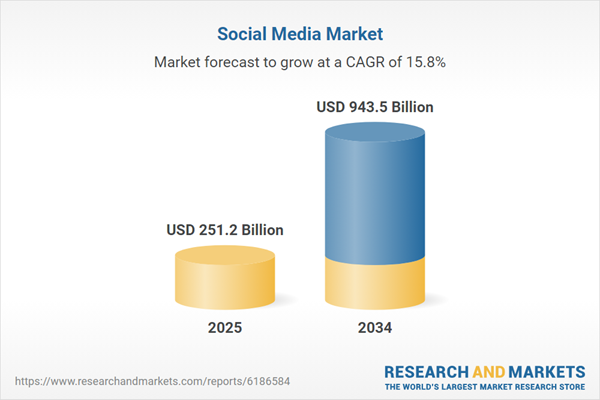The social media market has become one of the most influential pillars of the global digital economy, encompassing platforms that facilitate user interaction, content sharing, and real-time communication across personal, professional, and commercial domains. Social media platforms like Facebook, Instagram, TikTok, Twitter (X), LinkedIn, Snapchat, and YouTube now serve as multifaceted hubs for news, entertainment, marketing, shopping, and customer service. These networks have transformed how individuals connect and how businesses operate, becoming key channels for engagement, branding, and commerce. The market has expanded beyond casual use to include digital advertising, influencer marketing, social commerce, and enterprise-level communication tools. With billions of users globally and a continually evolving feature set, social media has become a competitive and fast-paced arena where companies must adapt to shifting user behaviors, emerging content formats, and platform algorithm changes. As user expectations for personalization, privacy, and value increase, social media companies are continuously innovating to stay relevant and retain engagement in an increasingly saturated landscape.
The social media market experienced notable transformation driven by content innovation, regulatory evolution, and AI integration. Short-form video continued to dominate user engagement, with platforms like TikTok and Instagram Reels leading the charge. AI-powered content recommendation systems became more nuanced, increasing user retention while also raising ethical questions about algorithmic influence. Major platforms introduced more in-app services, including digital storefronts, subscription models, and community-building features aimed at fostering creator loyalty and monetization. Meanwhile, data privacy remained at the forefront, prompting updates in user consent practices and greater investment in transparency tools. There was a significant push toward local content as regional creators gained visibility through algorithmic promotion, further diversifying the market. Additionally, cross-platform integrations became more sophisticated, allowing users and businesses to manage content, messages, and commerce across ecosystems seamlessly. These developments reflected a broader industry shift toward platform convergence, where social media increasingly intersects with e-commerce, entertainment, and productivity tools, blurring the boundaries of its traditional use cases.
The social media market is poised to deepen its influence through immersive experiences, ethical design, and decentralized infrastructure. Augmented reality (AR) and virtual reality (VR) are expected to become more integrated into mainstream platforms, enabling users to engage in 3D social environments, virtual events, and interactive shopping. Blockchain technology may reshape ownership and control, with users participating in decentralized social networks where they can own and monetize their content more transparently. Artificial intelligence will become more context-aware, personalizing content in real time while respecting user preferences and privacy. Meanwhile, platforms will be compelled to build trust by combating misinformation, moderating harmful content, and disclosing algorithmic processes. Governments are likely to implement more unified global standards for data protection, algorithm accountability, and digital competition, increasing compliance pressure on major tech firms. Social media’s next phase will be defined not just by how engaging it is, but by how responsibly and inclusively it evolves. The platforms that adapt to this balance - between innovation, monetization, and ethical responsibility - will lead the charge in shaping the future digital landscape.
Key Insights: Social Media Market
- Short-Form Video Dominance: Platforms continue to prioritize bite-sized, vertical video content, as users favor quick, digestible formats that deliver entertainment, news, and education in under a minute.
- Creator Monetization Tools: Social platforms are investing in tools that help creators earn through subscriptions, tipping, and branded content, strengthening platform loyalty and user retention.
- AI-Powered Personalization: Advanced AI systems are delivering highly customized feeds, improving engagement by tailoring content to individual behaviors and emotional patterns.
- Cross-Platform Ecosystems: Users are increasingly managing communications, commerce, and content across multiple platforms using unified tools and integrations that provide a seamless experience.
- Localized and Regional Content Growth: Platforms are boosting visibility of local creators and regional languages, expanding reach and relevance in emerging markets and culturally diverse regions.
- Rising Global Internet Penetration: Broader access to mobile internet continues to bring new users into the social ecosystem, particularly in rural and emerging markets.
- Demand for Real-Time Engagement: Users and brands alike are embracing live streaming, instant messaging, and interactive formats to foster immediate, meaningful connections.
- Digital Advertising Growth: Businesses are allocating larger portions of their marketing budgets to social platforms due to precise targeting and measurable ROI, driving continued innovation and revenue.
- Shift in Consumer Behavior: Social media has become central to how people discover products, consume news, and interact with communities, making it indispensable to digital lifestyle habits.
- Regulatory and Ethical Scrutiny: Increasing concerns around misinformation, mental health impact, data misuse, and algorithmic bias are leading to greater global regulation. Platforms must navigate compliance while preserving user experience and maintaining operational agility.
Social Media Market Segmentation
By Type
- Social Media Advertisement
- Social Media Subscription
By Service
- Social Networking
- Micro Blogging and Instant Messaging
- Photo Sharing Networks
By End-User Industry
- Retail and Wholesale
- Transportation Manufacturing
- Food and Beverages
- Financial Services
- Information Technology
- Electrical and Electronics Manufacturing
- Media and Recreation
- Transportation Services
- Healthcare
- Other End-User Industries
Key Companies Analysed
- Meta Platforms Inc.
- Youtube LLC
- Instagram LLC
- Twitter Inc.
- LinkedIn Corporation
- Snap Inc.
- Pinterest Inc.
- TikTok Inc.
- Reddit Inc.
- WhatsApp Messenger
- Tumblr
- Discord Inc.
- Twitch Interactive Inc.
- Foursquare Labs Inc.
- Yelp Inc.
- Nextdoor Inc.
- VKontakte Ltd.
- Sina Weibo
- LINE Corporation
- Viber Media Sàrl
- Telegram Messenger LLP
- Meetup Inc.
- Tagged
- Hi5
- XING SE
- Renren Inc.
- Bebo Inc.
- Ning Inc.
- Classmates Online Inc.
Social Media Market Analytics
The report employs rigorous tools, including Porter’s Five Forces, value chain mapping, and scenario-based modeling, to assess supply-demand dynamics. Cross-sector influences from parent, derived, and substitute markets are evaluated to identify risks and opportunities. Trade and pricing analytics provide an up-to-date view of international flows, including leading exporters, importers, and regional price trends.Macroeconomic indicators, policy frameworks such as carbon pricing and energy security strategies, and evolving consumer behavior are considered in forecasting scenarios. Recent deal flows, partnerships, and technology innovations are incorporated to assess their impact on future market performance.
Social Media Market Competitive Intelligence
The competitive landscape is mapped through proprietary frameworks, profiling leading companies with details on business models, product portfolios, financial performance, and strategic initiatives. Key developments such as mergers & acquisitions, technology collaborations, investment inflows, and regional expansions are analyzed for their competitive impact. The report also identifies emerging players and innovative startups contributing to market disruption.Regional insights highlight the most promising investment destinations, regulatory landscapes, and evolving partnerships across energy and industrial corridors.
Countries Covered
- North America - Social Media market data and outlook to 2034
- United States
- Canada
- Mexico
- Europe - Social Media market data and outlook to 2034
- Germany
- United Kingdom
- France
- Italy
- Spain
- BeNeLux
- Russia
- Sweden
- Asia-Pacific - Social Media market data and outlook to 2034
- China
- Japan
- India
- South Korea
- Australia
- Indonesia
- Malaysia
- Vietnam
- Middle East and Africa - Social Media market data and outlook to 2034
- Saudi Arabia
- South Africa
- Iran
- UAE
- Egypt
- South and Central America - Social Media market data and outlook to 2034
- Brazil
- Argentina
- Chile
- Peru
Research Methodology
This study combines primary inputs from industry experts across the Social Media value chain with secondary data from associations, government publications, trade databases, and company disclosures. Proprietary modeling techniques, including data triangulation, statistical correlation, and scenario planning, are applied to deliver reliable market sizing and forecasting.Key Questions Addressed
- What is the current and forecast market size of the Social Media industry at global, regional, and country levels?
- Which types, applications, and technologies present the highest growth potential?
- How are supply chains adapting to geopolitical and economic shocks?
- What role do policy frameworks, trade flows, and sustainability targets play in shaping demand?
- Who are the leading players, and how are their strategies evolving in the face of global uncertainty?
- Which regional “hotspots” and customer segments will outpace the market, and what go-to-market and partnership models best support entry and expansion?
- Where are the most investable opportunities - across technology roadmaps, sustainability-linked innovation, and M&A - and what is the best segment to invest over the next 3-5 years?
Your Key Takeaways from the Social Media Market Report
- Global Social Media market size and growth projections (CAGR), 2024-2034
- Impact of Russia-Ukraine, Israel-Palestine, and Hamas conflicts on Social Media trade, costs, and supply chains
- Social Media market size, share, and outlook across 5 regions and 27 countries, 2023-2034
- Social Media market size, CAGR, and market share of key products, applications, and end-user verticals, 2023-2034
- Short- and long-term Social Media market trends, drivers, restraints, and opportunities
- Porter’s Five Forces analysis, technological developments, and Social Media supply chain analysis
- Social Media trade analysis, Social Media market price analysis, and Social Media supply/demand dynamics
- Profiles of 5 leading companies - overview, key strategies, financials, and products
- Latest Social Media market news and developments
Additional Support
With the purchase of this report, you will receive:- An updated PDF report and an MS Excel data workbook containing all market tables and figures for easy analysis.
- 7-day post-sale analyst support for clarifications and in-scope supplementary data, ensuring the deliverable aligns precisely with your requirements.
- Complimentary report update to incorporate the latest available data and the impact of recent market developments.
This product will be delivered within 1-3 business days.
Table of Contents
Companies Mentioned
- Meta Platforms Inc.
- Youtube LLC
- Instagram LLC
- Twitter Inc.
- LinkedIn Corporation
- Snap Inc.
- Pinterest Inc.
- TikTok Inc.
- Reddit Inc.
- WhatsApp Messenger
- Tumblr
- Discord Inc.
- Twitch Interactive Inc.
- Foursquare Labs Inc.
- Yelp Inc.
- Nextdoor Inc.
- VKontakte Ltd.
- Sina Weibo
- LINE Corporation
- Viber Media Sàrl
- Telegram Messenger LLP
- Meetup Inc.
- Tagged
- Hi5
- XING SE
- Renren Inc.
- Bebo Inc.
- Ning Inc.
- Classmates Online Inc.
Table Information
| Report Attribute | Details |
|---|---|
| No. of Pages | 160 |
| Published | October 2025 |
| Forecast Period | 2025 - 2034 |
| Estimated Market Value ( USD | $ 251.2 Billion |
| Forecasted Market Value ( USD | $ 943.5 Billion |
| Compound Annual Growth Rate | 15.8% |
| Regions Covered | Global |
| No. of Companies Mentioned | 30 |









